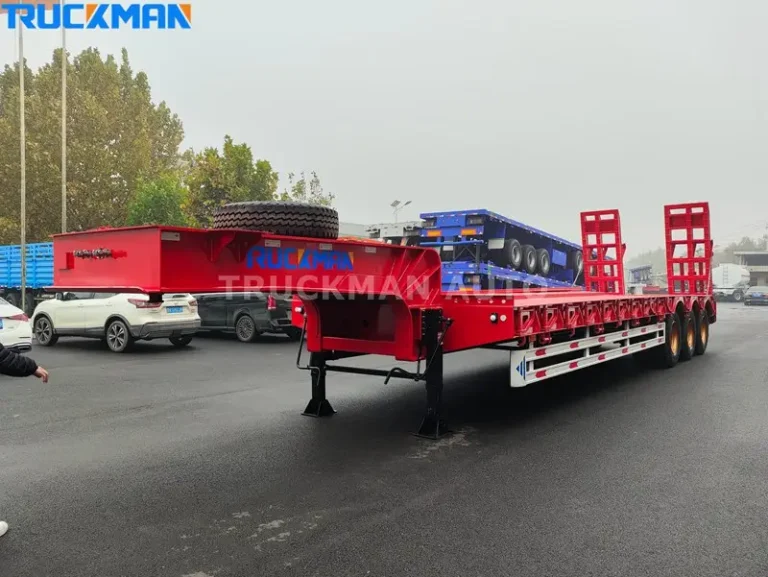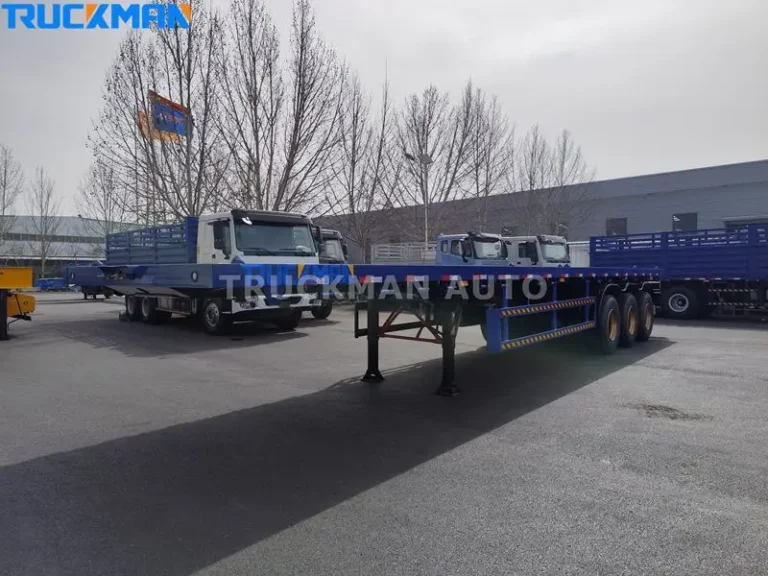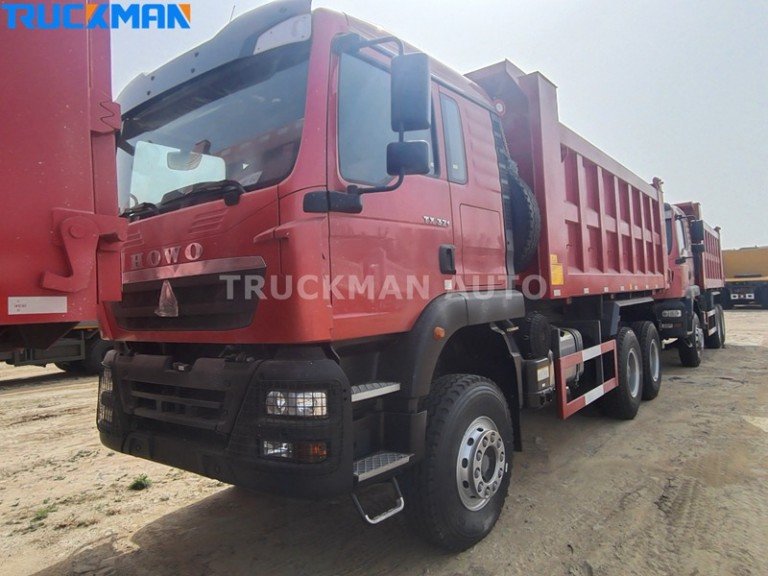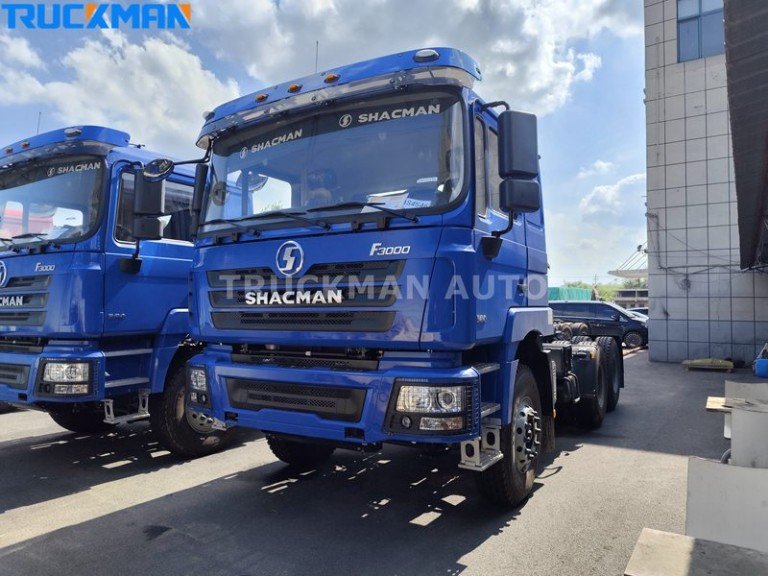The dump semi trailer is a semi-trailer suitable for transporting bulk and piecemeal cargoes such as coal, ore, earthworks, and building materials. Dump semi trailers are widely used across various industries due to their unique unloading method and high efficiency. Particularly in the construction industry, dump semi trailers enable quick unloading, eliminating the need for manual handling, thereby significantly improving work efficiency. They are ideal for transporting large building materials like gravel, bricks, and concrete, easily meeting various process requirements and providing convenience for construction tasks. So, what are the types of dump semi trailers? This article will specifically analyze the types of dump semi trailers to help readers choose the right semi trailer.

Table of Contents
Standard Dump Semi Trailer
The standard design of dump semi trailers includes aspects such as compartment design, lifting devices, passability, braking equipment, and performance requirements. Common uses for dump semi trailers in construction and road building include transporting building materials and waste removal. Dump semi trailers primarily use the vehicle’s hydraulic system for unloading materials.
Dump semi trailers are widely used for transporting bulk materials such as construction waste, sand, and gravel. They can navigate narrow site roads while offering large capacities to transport materials to designated locations conveniently and quickly. They are also used for transporting mined coal, ore, and other materials from the mining site to outside locations for further processing and transshipment.
Dump semi trailers can be quickly loaded and unloaded through the equipped automatic lifting system, greatly saving loading and unloading time and labor costs. Compared to traditional manual methods, this automatic operation not only improves working efficiency but also reduces the intensity of human labor. Additionally, dump semi trailers offer overall stiffness, good toughness, high strength, strong lifting force, and robust bearing capacity.

U-Type Dump Trailer
The U-type dump trailer adopts a streamlined internal structure with arc transitions at the corners, eliminating dead angles. This design prevents materials from sticking to the box during unloading, resulting in faster, more thorough, and cleaner unloading. The residual rate after unloading is nearly zero. In winter, when sand and cargo boxes often freeze, or when loess and clay cannot be fully unloaded in municipal projects, using U-type dump trailers can greatly improve efficiency.
Common rectangular dump trailers strengthen their cargo boxes by thickening the board and reinforcing the frame structure. However, the U-type dump trailer uses high-strength plates and optimized structures to ensure box strength while reducing weight. The plate thickness is reduced by about 20%, and integrated processing minimizes reinforcement ribs, significantly reducing dead weight and improving the load utilization factor.
The bottom of the U-type dump trailer is curved, eliminating the bottom longitudinal beam and lowering the subframe compared to a rectangular cargo box, resulting in a lower center of gravity. This makes the U-type dump trailer very stable when driving on mining roads, effectively reducing chassis wear on heavy-loaded engineering vehicles. Additionally, the U-type dump trailer prevents cargo from falling when turning quickly on the road, providing greater stability and safety.

Side Dump Trailer and Rear Dump Trailer
Comparison with Side Dump Trailer: The side dump trailer, with its low lifting height and low center of gravity, is less prone to rollover accidents. In contrast, the rear dump trailer has a very high lifting height, causing the center of gravity to become extremely unstable, making it susceptible to rollovers if the ground is uneven during unloading. Generally, the side dump trailer requires a large, wide, and flat unloading site, while the rear dump trailer only requires the site to be flat and free of obstructions.
Advantages of Side Dump Trailers: Side dump trailers allow for the safe unloading of cargo along the trailer, providing flexibility in tight spaces and minimizing the risk of rollover. Side dump trailers are equipped with hydraulic systems to ensure smooth operation, making them easy to use and maintain.
When to Choose Each Type: At large construction sites, quarries, and farms with narrow or uneven terrain, side dump trailers simplify operations by facilitating loading and unloading, saving time and labor costs. Rear tipping dump trailers are used to transport and unload all kinds of bulk materials, such as gravel, coal, soil, and grain.
Super Dump Trailer
Super dump trailers are suitable for transporting bulk and scattered goods such as coal, ore, and building materials. Dump trailers can be divided into two categories based on their uses: heavy-duty and super-heavy dump trailers for off-road transportation, which are mainly used in large mines and engineering projects, typically in conjunction with excavators; and light to medium-sized ordinary dump trailers for road transportation, primarily used for transporting loose goods such as sand, gravel, soil, and coal. Dump trailers are usually paired with loaders. The carriage adopts side-overturning and rear-overturning self-unloading methods, effectively improving the transportation efficiency of loaders and unloaders when transporting bulk and scattered goods. The frame and carriage longitudinal beams are welded with high-quality manganese plates. The cargo box of the dump trailer comes in two types: dustpan and rectangular, offering high strength, strong lifting force, good rigidity and toughness, strong carrying capacity, no deformation, and excellent workmanship.
The front hydraulic jack of the dump semi-trailer has a long lifting range, providing a relatively large lifting force, making it more suitable for lifting heavy objects such as slag and coal. The front jack also has the advantages of fast lifting speed, simple structure, and easy maintenance. However, this lifting method also has certain disadvantages. When the weight of the loading and unloading goods is unevenly distributed, it can lead to a heavyweight phenomenon, causing the jack to bend, affecting the telescopic lifting, and even posing the risk of jack breakage.
The side-rolling hydraulic jack does not have stringent requirements for the length of the jack rod and is distributed in a row at the bottom of the cargo compartment. If mobile legs are used at the rear of the vehicle, the cargo can be prevented from burying the tire during unloading. However, side-rolling lifting also has disadvantages, such as higher requirements for the unloading site and uneven force on the beam during unloading. Typically, side-rolling hydraulic jacks are used on trailers with cargo compartments longer than 9.6 meters.

Heavy Duty Dump Trailer
Built for Hard Work: Improvements have been made to the structure and stress points of the dump trailer. Reinforcements have been added to the beam, the suspension diagonal support plate has been changed to a straight plate to increase rigidity, and the compartment has been supported by densified reinforcements. All the column baffles have undergone flanging treatment to avoid stress concentration and prevent cracking caused by partial stress on some dump trailers. These enhancements provide effective torsion resistance, ensuring that the full load is evenly stressed, and the frame is solid and durable.
Main Features: The entire vehicle body is made of high-quality, high-strength steel with stable and reliable plate performance. After finite element analysis and design, the dump trailer has advantages such as a beautiful appearance, reasonable structure, lightweight, and strong load-bearing capacity. The trailer is equipped with a high-capacity suspension system, and the tie rod angle is reasonably designed to reduce the instantaneous friction slip distance between the tires and the ground, effectively reducing tire wear and providing a strong guarantee for safe driving.
Ideal Industry: It is suitable for transporting bulk goods such as coal, ore, earthworks, and construction materials.

Off-Road Rear Dump Semi Trailer
Reinforced Chassis: The chassis design emphasizes the use of high-strength materials and an independent chassis design, ensuring stable carrying capacity and a good driving experience under extreme road conditions.
Extra Large Tires: To enhance off-road capability and carrying capacity, off-road rear dump semi trailers usually use special tires. These tires have larger particle clearance, providing excellent off-road capability, a large approach angle, and strong climbing ability, effectively enhancing the trailer’s passability and carrying capacity.
Ground Clearance: High ground clearance ensures that the chassis will not be damaged when the trailer passes through complicated road conditions, improving the trailer’s passability and off-road performance.
Application: Suitable for industries where rugged terrain is common, such as logging, mining, and civil engineering.
Specialized Self-Dumping Semi Trailer
Classification
Low-profile End Dump Semi Trailer: Generally used for transporting coal, ore, and other materials, using side or rear tipping self-unloading modes to improve loading and unloading efficiency while reducing manual labor intensity.
Transfer Dump Semi Trailer: This type of trailer has a strong carrying capacity and self-unloading functions, making it suitable for transporting grain and other bulk goods, allowing for quick material transfer.
Asphalt Dump Semi Trailer: Specifically designed for transporting liquid asphalt over long, medium, and short distances, it adopts an automatic ignition diesel burner for heating and heat preservation, ensuring that asphalt remains at the proper temperature during transport.
Features
Low-profile End Dump Semi Trailer: To better transport ores and other materials, the cargo box is made of high-strength, wear-resistant plates, reducing maintenance frequency.
Transfer Dump Semi Trailer: The top is equipped with a quick-loading chute, improving grain loading efficiency, ensuring good sealing, and effectively avoiding grain contamination problems. The compartment structure is optimized to enable large-capacity transport and reduce transportation costs.
Asphalt Dump Semi Trailer: Equipped with an imported heater with an air blower, it offers good heating and heat preservation, along with functions such as self-flow unloading and pumping unloading, further enhancing transportation efficiency and convenience.
Factors To Consider When Choosing a Dump Trailer
Load Capacity: Selecting the appropriate size and load capacity of the cargo box is based on actual needs to ensure that transport and loading requirements can be met. This involves assessing the vehicle’s load capacity and dimensions to match the specific transport task.
Quality of Key Accessories: The quality of key accessories, such as axles, hydraulic systems, and tires, directly affects the performance and safety of the vehicle. Choose reliable parts, such as imported or joint-venture brand axles (e.g., BPW, FUWA, ZY) and brand-guaranteed tires (e.g., TRIANGLE, LINGLONG), along with HYVA brand hydraulic lifting systems.
Vehicle Design and Materials: The vehicle design should be well thought out, with the chassis center of gravity as low as possible to meet different usage needs. Solid materials should be used, with high-quality steel and other key components chosen to ensure the vehicle’s durability and safety. For example, using wear-resistant steel for the cargo box will significantly extend its service life compared to ordinary carbon steel.
Testing and Validation: After manufacturing, the vehicle should undergo rigorous testing and validation to ensure its performance and quality meet design requirements. This includes load tests, driving tests, and environmental adaptability tests to ensure reliability and durability.
Summary
As illustrated in the above article, different types of dump semi trailers have distinct characteristics. The U-type dump semi trailer is ideal for transporting sticky goods, ensuring clean unloading with no residue. The off-road dump semi trailer excels in rough road conditions, making it perfect for mining operations. The side dump trailer effectively mitigates the risk of vehicle overturning during unloading, balancing loading capacity with improved safety. Customers should evaluate their specific needs and consider the unique features of each type of dump semi trailer before making a purchase. Additionally, you are welcome to visit our offices and factories in China to explore more options and find the most suitable dump semi trailer for your needs.
FAQ
The main difference lies in the method of unloading. Rear dump trailers unload cargo to the rear using a lifting mechanism at the front of the vehicle, while side dump trailers tilt the cargo to the sides through a lifting device at the bottom.
No. Due to the inadequate sealing of the cargo box, rear dump trailers cannot transport liquid goods, but they are suitable for transporting large goods like granules.
The heavy haulage trailer transport industry is one of the primary application areas for heavy-duty dump trailers. This industry benefits greatly from using these trailers due to steady revenue sources and continuous growth in logistics demand.
Reasonable loading quantities maximize the vehicle’s transport capacity, reduce transport costs, and improve efficiency. Using GPS navigation and map software helps plan the best route, avoid traffic jams, and shorten travel time.
Key factors include defining the purchase purpose, determining the budget, selecting the vehicle brand, and considering construction conditions, transport distances, material types, ancillary equipment, and climatic conditions.






